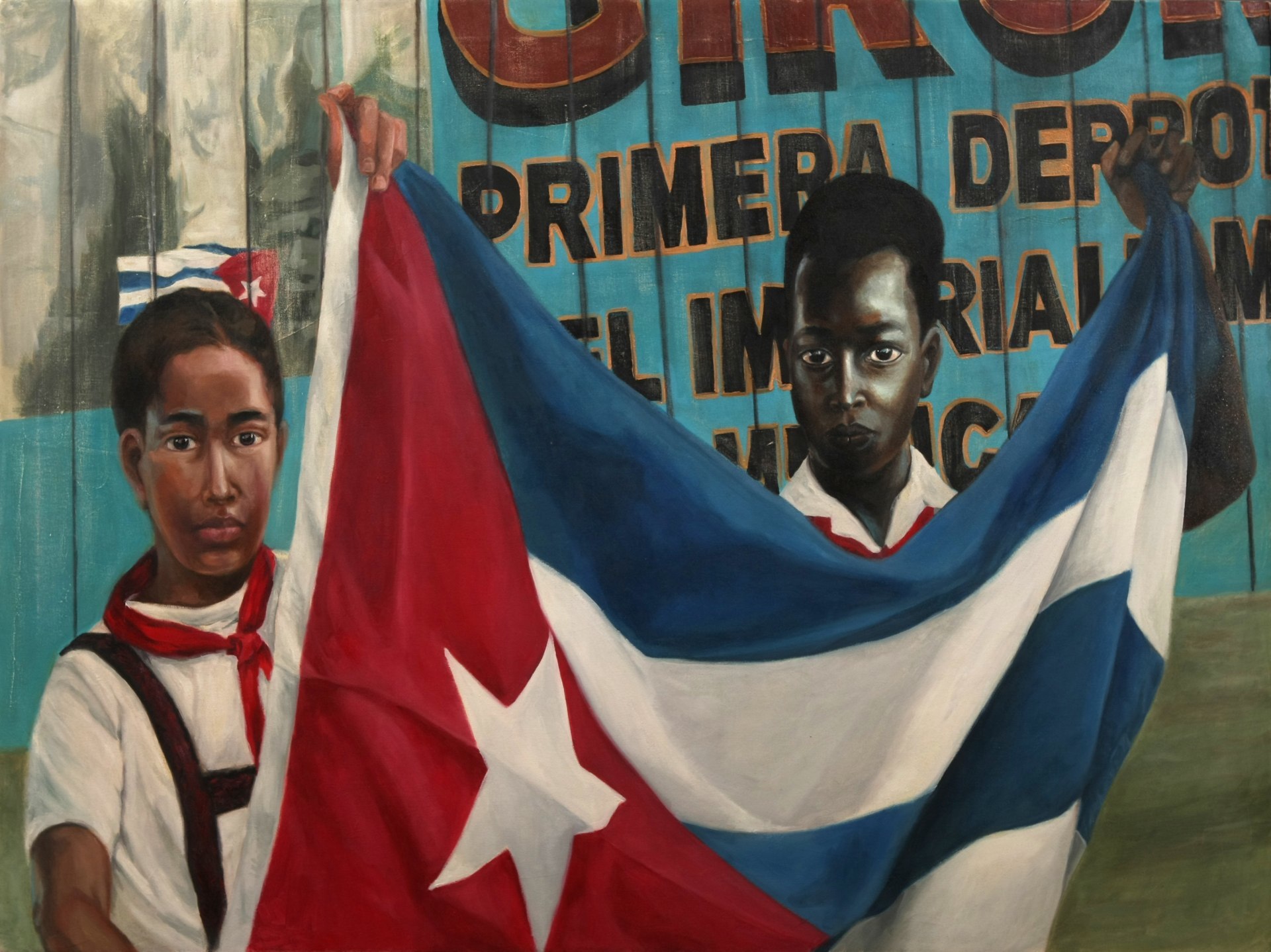 |
| The Pioneers / 2009-10
In this continuation of the exchange between Marketing Director Julieth Maya Buri and the artist who created the artwork for Ardiente Paciencia, Tatiana Garmiendo discusses the intersection of poetry and politics in her artwork and upcoming show in the lobby of Milagro.
|
A: Skarmeta’s Ardiente Paciencia spoke to me on several levels.
On the one hand, the idea that poetry belongs not to the poet but to the lover
who uses it seized my imagination instantly. Artists work for themselves, of
course, they create out of an irresistible imperative, a drive to give voice to
ideas and feelings. But that drive doesn’t belong only to them, it belongs to
the world, to the community of souls. Skarmeta’s Beatriz and Mario are his
creations, as frankly, is his version of Pablo Neruda. But they are more than
his. They manifest every lover seized by passion. The political anxieties in
the play reach beyond Chile and a moment in history. They reflect the groaning
yearning for peace and justice humanity has felt throughout time.
In the play, Skarmeta quotes Neruda’s poem to his wife, and
the verse, “Desnuda eres azul como la noche en Cuba, tienes enredaderas y
estrellas en el pelo” spoke to me very directly. I simply had to include them
in the image of the lovers. The nudity in Neruda’s poem is erotic, clearly, it
is a love poem. But it’s also metaphoric of another nudity, that transparency
of being that transcends physicality when you truly see the loved one. That’s
why she has vines and stars in her hair. She’s become creation itself. And I,
who carry bits and pieces of my country in my DNA, in my memories, at once
defined and not defined by my Cubanness desire to be seen like that. I hunger for the skies of my lost homeland to
be detected on my skin, in my touch, in my art.
Q: What can be expected by the visitors to your exhibit during the run of Ardiente Paciencia at Milagro Theatre?
A: The pieces will have political content and like the play
will be also be highly romantic. Like
the piece I created for the postcard in response to Ardiente Paciencia, expect
the exhibition to additionally connect emotionally and esthetically to our current
struggles for peace and justice in the world.
The Garden of Joys series reinvents the armed encounters
between Western and Islamic cultures outside all political paradigms. Erotic
figures erupt into an imagined terrain of splendor in Muhammad al-Idrisi’s lost
mappa mundi. Boundaries between
lovers, gardens, and maps dissolve.
For these works, I literally burned into the surface of
handmade papers. In places, the drawn marks char completely through the
support, emphasizing the fragility of the unifying surface. Watercolor accents
visually cool off this blistering effect.
In some of the maps a “key” in Arabic or Hebrew “unlocks”
the revelation of the imaginal map. The keys are quotes from famous Hollywood romantic
films. Understanding this terrain of splendor depends on whether or not you get
that truth doesn’t just come to us in the form of exalted theories. It breaks
through even in the sentimental utterings of popular media. That even when the
world seems to be crumbling to rubble around us, the solution we seek really
is, “Love is a many splendored thing: Love lifts us up where we belong; All you
need is love.”
El arte, la poesía y la política: Garmiendo, 2a. Parte
P: En la postal de Ardiente Paciencia se lee un verso de uno de los poemas de Pablo Neruda. ¿Qué te atrajo a seleccionar ese fragmento del poema para la creación de imagen?
La obra “Ardiente Paciencia” me inspiró en varios niveles. Por un lado, la idea de que la poesía no le pertenece al poeta sino a el amante que la utiliza se apoderó de mi imaginación al instante. Los artistas trabajan para sí mismos, por supuesto, crean a partir de un imperativo irresistible, una propulsión que da voz a ideas y sentimientos. Pero ese empuje no pertenece sólo al artista, le pertenece al mundo, a la comunidad de las almas. Beatriz y Mario son las creaciones de Skármeta, igualmente su versión de Pablo Neruda. Pero son más que suyos. Se manifiestan en cada amante incautado por la pasión. Las ansiedades políticas en el libreto alcanzan más allá de Chile y un momento en la historia. Mas bien reflejan el anhelo por la paz y la justicia que la humanidad ha sentido a lo largo de todo el tiempo.
En la obra, Skármeta cita el poema de Neruda a su esposa. El verso, “Desnuda eres azul como la noche en Cuba, tienes enredaderas y estrellas en el pelo” me afectó muy directamente. Simplemente tenía que incluirlos en la imagen de los amantes. La desnudez en el poema es erótica, claramente, es un poema de amor. Pero también es metafórica de otra desnudez, la transparencia del ser que trasciende lo físico cuando realmente ve al ser querido. Es por eso que ella tiene enredaderas y estrellas en el pelo. Se ha convertido en la creación misma. Y yo, que llevo trozos de mi país en mi ADN, en mis recuerdos, a la vez definida y no definida por mi cubanindad, quiero ser transparente de esa manera. Anhelo que los cielos de mi patria perdida sean detectados en mi piel, en mi tacto, en mi arte.
P: ¿Qué pueden esperar los visitantes del teatro de tu exhibición durante los días que Ardiente Paciencia se presenta en el Teatro Milagro?
R: Los dibujos tienen un contenido político y, como la obra de teatro, serán también muy románticos. Al igual que la obra que creé para la tarjeta postal en respuesta a Ardiente Paciencia, pueden esperar que la exposición también connecte emocional y estéticamente a nuestras luchas actuales para la paz y la justicia en el mundo.
La serie “El Jardín de Las Alegrías” reinventa los encuentros armados entre las culturas occidentales e islámicos fuera de todo paradigma político. Figuras eróticas estallan en un terreno imaginario de esplendor en los mapas perdidos de Muhammad-al-Idrisi. Los límites entre los amantes, los jardines y los mapas se disuelven.
Para estos dibujos, literalmente queme los amantes sobre la superficie de papeles hechos a mano. A veces las marcas dibujadas carbonizan completamente a través del apoyo , haciendo hincapié en la fragilidad del papel . Acentos en acuarela enfrían visualmente este efecto abrasador .
En algunos de los mapas de una “clave ” en árabe o hebreo ” desbloquea ” la revelación del mapa imaginal . Las claves son citas de famosas películas románticas de Hollywood. La comprensión de este terreno de esplendor depende de si o no usted acuerda que la verdad no sólo viene a nosotros en la forma de teorías exaltadas . Se descubre incluso en los pronunciamientos sentimentales de los medios de comunicación populares. Que aun cuando el mundo parece estar desmoronándose a escombros alrededor de nosotros , la solución que buscamos realmente es: ” El amor es una cosa esplendorosa: El amor nos lleva a donde pertenecemos; Todo lo que necesitas es el amor.”

